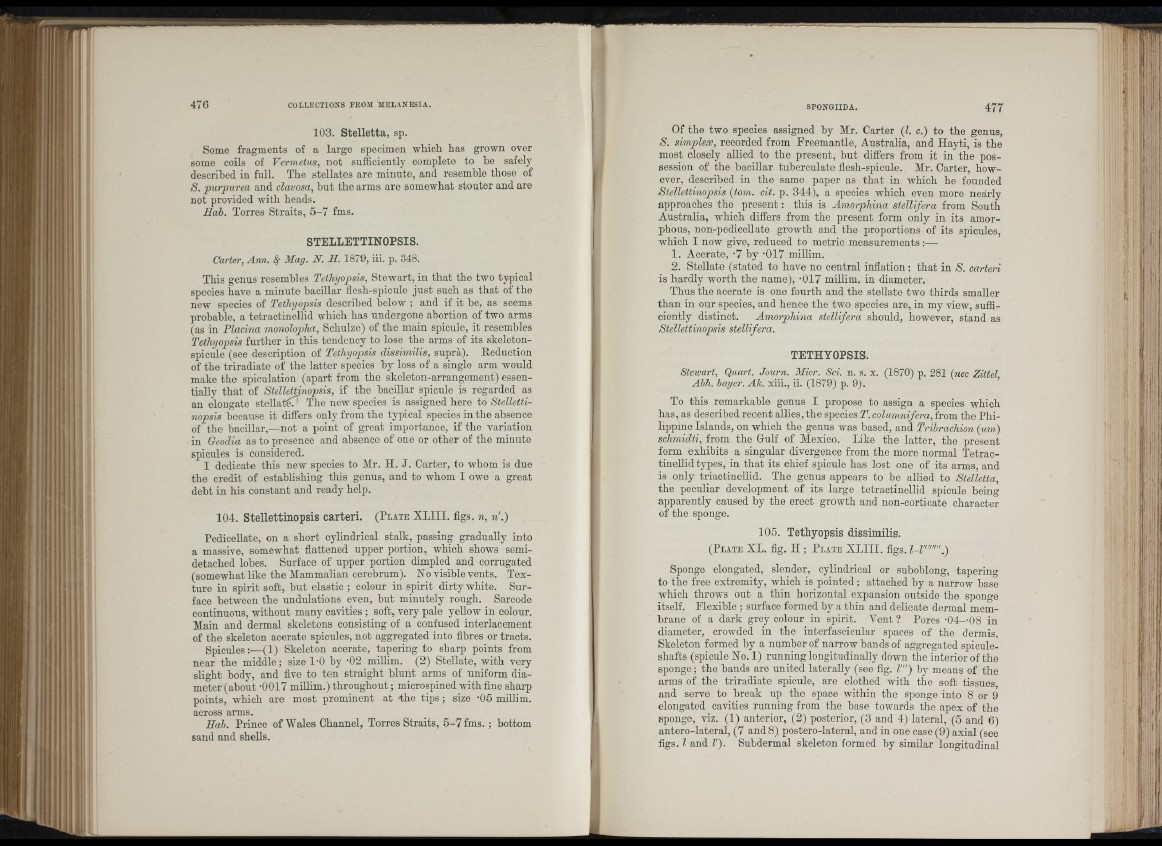
r.i
i;
I
i t
i 'i *
i* t* f:
il '
IIH " *
51+ * ■
ái;; 1
1St! ’“■ ‘
i■ i1J:1,1';1
flilL ;
l i l lü B
I,
Í!
COLLECTIONS FROM M ELA N E SIA .
103. Stelletta, sp.
Some fragments of a large specimen which has grown over
some coils of Vermetus, not sufficiently complete to he safely
described in full. The stellates are minute, and resemble those of
S . purpurea and clavosa, but the arms are somewhat stouter and aro
not provided with heads.
Hab. Torres Straits, 5 -7 fms.
STELLETTINOPSIS.
Carter, Ann. S; Mag. H. H. 1879, iii. p. 348.
This genus resembles Tethyopsis, Stewart, in th at the two typical
species have a minute hacillar liesh-spicule ju s t such as th at of the
new species of Tethyopsis described below ; and if it be, as seems
probable, a tetractinellid which has undergone abortion of two arms
(as in Placina monolopha, Schulze) of the main spicule, it resembles
Tethyopsis further in this tendency to lose the arms of its skeleton-
spicule (see description of Tethyopsis dissimilis, supra). Reduction
of the triradiate of the latter species hy loss of a single arm would
make the spiculation (apart from the skeleton-arrangement) essentially
th a t of Stellettinopsis, if the hacillar spicule is regarded as
an elongate stellatm ' The new species is assigned here to Stellettinopsis
because it differs only from the typical species in the absence
of the hacillar,—not a point of great importance, if the variation
■ in Oeodia as to presence and absence of one or other of the minute
spicules is considered.
I dedicate this new species to Mr. H. J. Carter, to whom is due
the credit of establishing this genus, and to whom I owe a great
debt in his constant and ready help.
104. Stellettinopsis carteri. ( P l a t e X L III. figs. n, n .)
Pedicellate, on a short cylindrical stalk, passing gradually into
a massive, somewhat flattened upper portion, which shows semidetached
lobes. Surface of upper portion dimpled and corrugated
(somewhat like the Mammalian cerebrum). No visible vents. Texture
in spirit soft, hut elastic ; colour in spirit dirty white. Surface
between the undulations even, but minutely rough. Sarcode
continuous, without many cavities ; soft, very pale yeUow in colour.
Main and dermal skeletons consisting of a confused interlacement
of the skeleton acerate sjhcules, not aggregated into fibres or tracts.
Spicules:—(1) Skeleton acerate, tapering to sharp points from
near the middle; size 1-0 hy -02 millim. (2) Stellate, with very
slight body, and five to ten straight blunt arms of uniform diameter
(ab o u t-0017 millim.) throughout; microspined with fine sharp
points, which are most prominent at the tip s ; size -05 millim.
across arms.
Hah. Prince of Wales Channel, Torres Straits, 5 -7 fm s .; bottom
sand and shells.
SPO N G IID A . 477
Of the two species assigned by Mr. Carter {I. c.) to the genus,
S. simplex, recorded from Ereemantle, Australia, and Hayti, is the
most closely allied to the present, but differs from it in the possession
of the hacillar tuberculate flesh-spicule. Mr. Carter, however,
described in the same paper as th at in which he founded
Stellettinopsis (tom. cit. p. 344), a species which even more nearly
approaches the p re s e n t: this is Amorphina stellifera from South
Australia, which differs from the present form only in its amorphous,
non-pedicellate growth and the proportions of its spicules,
which I now give, reduced to metric measurements:—
1. Acerate, *7 by '017 millim.
2. Stellate (stated to have no central inflation ; th at in S. carteri
is hardly worth the name), -017 millim. in diameter.
Thus the acerate is one fourth and the stellate two thirds smaller
than in our species, and hence the two species are, in my view, sufficiently
distinct. Amorphina stellifera should, however, stand as
Stellettinopsis stellifera.
TETHYOPSIS.
Stewart, Quart. Journ. Micr. Sci. n. s. x. (1870) p. 281 (nec Zittel
Abh. bayer. Ak. xiii., ii. (1879) p. 9).
To this remarkable genus I propose to assign a species which
has, as described recent allies, the species T. columnifera, from the Philippine
Islands, on which the genus was based, and Trihrachion (urn)
schmidti, from the Gulf of Mexico. Like the latter, the present
form exhibits a singular divergence from the more normal Tetractinellid
types, in th at its chief spicule has lost one of its arms, and
is only triactinellid. The genus appears to be allied to Stelletta,
the peculiar development of its large tetractinellid spicule being
apparently caused by the erect growth and non-corticate character
of the sponge.
105. Tethyopsis dissimilis.
( P l a t e XL. fig. H ; P l a t e X L III. figs. l-l"
Sponge elongated, slender, cylindrical or suboblong, tapering
to the free extremity, which is pointed; attached hy a narrow base
which throws out a thin horizontal expansion outside the sponge
itself. Flexible ; surface formed hy a thin and delicate dermal membrane
of a dark grey colour in spirit. Vent? Pores -04--08 in
diameter, crowded in the interfascicular spaces of the dermis.
Skeleton formed by a number of narrow hands of aggregated spicule-
shafts (spicule No. 1) running longitudinally down the interior of the
sponge; the hands are united laterally (seo fig. V") by means of the
arms of the triradiate spicule, are clothed with the soft tissues,
and serve to break up the space within the sponge into 8 or 9
elongated cavities running from the base towards the apex of the
sponge, viz. (1) anterior, (2) posterior, (3 and 4) lateral, (5 and 6)
antero-lateral, (7 and 8) postero-lateral, and in one case (9) axial (see
figs. I and V). Suhdermal skeleton formed hy similar longitudinal
.!
i '
I
I I
k
i ’ij I
■1 i
Í;